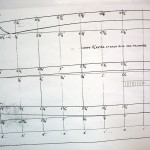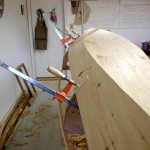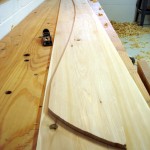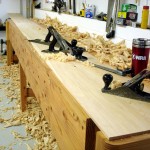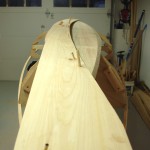 Slow and deliberate are good adjectives for my boat building methods. The “deliberate” is because I’m new to this, learning as I go, and approach unpracticed tasks with a little trepidation. The “slow” is just, well, slow. Since the last posting, I’ve removed and plugged 17 knots in each of the garboard planks, trimmed the upper edge of the planks to land precisely on the knuckles of the frames, and steamed the planks into place.
Slow and deliberate are good adjectives for my boat building methods. The “deliberate” is because I’m new to this, learning as I go, and approach unpracticed tasks with a little trepidation. The “slow” is just, well, slow. Since the last posting, I’ve removed and plugged 17 knots in each of the garboard planks, trimmed the upper edge of the planks to land precisely on the knuckles of the frames, and steamed the planks into place.
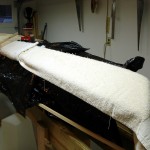 The garboard planks on this boat have a lot of twist (maybe I said that before). Harry Bryan, the designer, suggests that Northern cedar probably won’t have problems with the twist, but that other cedars might, and suggests steaming the planks. People who build lots of boats have steam boxes for such work. If I were building a Whitehall with 48 sets of frame, I’d probably build a steam box. Yet, for only two planks, I used an alternative method.
The garboard planks on this boat have a lot of twist (maybe I said that before). Harry Bryan, the designer, suggests that Northern cedar probably won’t have problems with the twist, but that other cedars might, and suggests steaming the planks. People who build lots of boats have steam boxes for such work. If I were building a Whitehall with 48 sets of frame, I’d probably build a steam box. Yet, for only two planks, I used an alternative method.
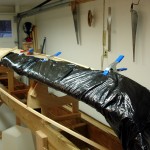 Wrap an end of the plank in a couple of old towels. Wrap the towels with plastic. Then, saturate the towels with boiling water. Draw up the plastic wrap to hold moisture and heat in. Repeat several times, to keep the plank hot, over a half-hour period. The wood becomes more pliable and is easily clamped or fixed in place. Sounds easy. Actually, it is. My only complication was having the 4 gallons of boiling water in big kettles on a stove one floor away from the shop. So, there were many trips with a small pan of water down and up the stairs. That actually worked out well, causing the dousing to be spread out over time. Of course, there’s spill over and water on the floor. That’s OK. The shop is a converted garage with a concrete floor. I used a 30 gallon trash can at the end of a plank to catch runoff. That seemed to work OK, until I went to empty it and found only about 1/2 inch of water in it. A “hole in my bucket” had transformed the can into a funnel. Oh well, the shop floor needed a good cleaning.
Wrap an end of the plank in a couple of old towels. Wrap the towels with plastic. Then, saturate the towels with boiling water. Draw up the plastic wrap to hold moisture and heat in. Repeat several times, to keep the plank hot, over a half-hour period. The wood becomes more pliable and is easily clamped or fixed in place. Sounds easy. Actually, it is. My only complication was having the 4 gallons of boiling water in big kettles on a stove one floor away from the shop. So, there were many trips with a small pan of water down and up the stairs. That actually worked out well, causing the dousing to be spread out over time. Of course, there’s spill over and water on the floor. That’s OK. The shop is a converted garage with a concrete floor. I used a 30 gallon trash can at the end of a plank to catch runoff. That seemed to work OK, until I went to empty it and found only about 1/2 inch of water in it. A “hole in my bucket” had transformed the can into a funnel. Oh well, the shop floor needed a good cleaning.
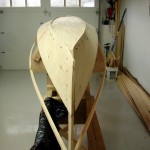 Two planks, four plank ends, four separate steaming sessions, about four gallons of water each. The shop, and the kitchen upstairs, were saunas for a while.
Two planks, four plank ends, four separate steaming sessions, about four gallons of water each. The shop, and the kitchen upstairs, were saunas for a while.
There aren’t many clamping spots, only the mid-frame and the two bulkheads. I used drywall screws along the runs between the clamps. The drywall screws will be removed after the planks are permanently fixed and their holes will be patched. I probably used more than I needed, adding yet one more reason for the slow part of my boat building.
Next step: The planks come off, an adhesive bed gets applied and the planks go back on with permanent fasteners.
